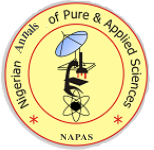Activity concentrations of 226^Ra, 232^Th, and 40^K in common maize meal consumed in Namibia and their potential radiation hazards
DOI:
Keywords:
Natural radioactivity, Maize meal, Daily intake, Excess lifetime cancer riskAbstract
Gamma spectroscopy was performed to determine the concentrations of 40K, 226Ra and 232Th in maize meal samples collected from shop outlets and open markets in Namibia. The activity concentrations and Excess Lifetime Cancer Risk were determined using a high purity germanium (HPGe) detector. The average activity concentrations of 40K, 226Ra and 232Th were found to be 29.98 ± 4.05, 0.99 ± 0.40 and 0.35 ± 0.08 Bq.kg – 1 in the maize meal samples. The result showed the activity concentrations of 40K significantly higher than the other radionuclides in all the maize meal samples. The average excess life cancer risk varies from 1.33 x 10 – 13 to 6.05 x 10 – 13 for 40K, 8.76 x 10 -13 to 1.19 x 10 – 12 for 232Th and 2.43 x 10 -11 to 2.83 x 10 – 11 for 226Ra. Hence, when compared with internationally acceptable limits, all values fall within the safety limits. Thus, the study concludes that the maize meals consumed in Namibia are radiologically safe for consumption.
Downloads
Published
How to Cite
Issue
Section
License
Copyright (c) 2021 SA Onjefu, NN Kafidi, C Kamunda, PI Uloko, M Hitila, E Ejembi, J Kennedy

This work is licensed under a Creative Commons Attribution-ShareAlike 4.0 International License.



 Contact Us
Contact Us Editorial Team
Editorial Team Join As A Reviewer
Join As A Reviewer  Request For Print Copy
Request For Print Copy


 Cprint Publishers
Cprint Publishers